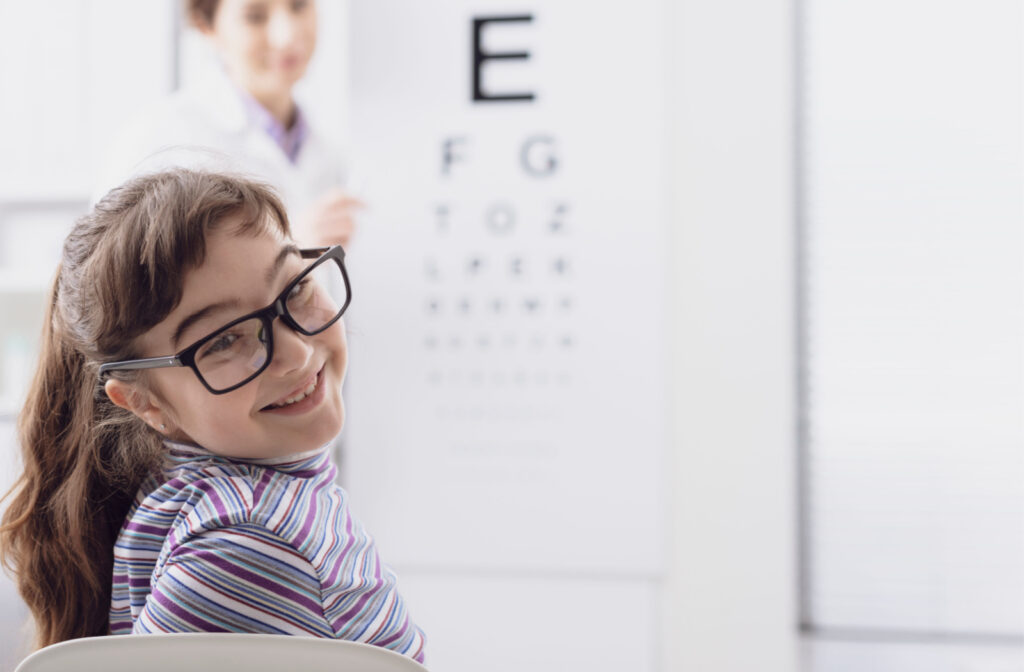Developing healthy eyesight plays a role in your child’s academic and social growth. Eye exams can help detect any early vision problems that may lead to learning difficulties or other complications.
Regular eye exams can provide peace of mind for parents, knowing that their child’s vision is being monitored and any issues can be addressed early on. It’s recommended that kids should have their first eye exam between 6–12 months, one more exam between 3–5 years, and annual exams from 6–17. Regular eye exams can help detect underlying health issues like diabetes or high blood pressure that may affect your child’s vision.
Additionally, eye exams can also help identify potential underlying health issues, such as diabetes or high blood pressure. Ensuring your child receives regular eye exams is a proactive and responsible way to support their overall health and well-being.
Eye Exam Schedule for Kids
Eye Exam Recommendation for Infants & Toddlers
Regular eye exams should be essential to every child’s healthcare routine. Not only do these exams help correct your child’s vision, but they can also detect underlying health issues that may manifest in the eyes.
These exams can identify early vision problems that may potentially lead to learning difficulties or other complications. Catching these issues early on can help prevent them from becoming more serious and impacting your child’s quality of life.
Additionally, regular eye exams can provide you with peace of mind, knowing that your child’s eyes are healthy and functioning properly. That is why it’s recommended that kids should have their first eye exam between 6–12 months and one more exam between 3–5 years.
Eye Exam Recommendation for School-Age Children
Regular eye exams are essential for school-age children to help promote healthy vision. School-age children should have an eye exam before beginning first grade and annually after that unless advised otherwise by their eye doctor.
These exams can help detect issues such as nearsightedness, farsightedness, astigmatism, and conditions like lazy eye or color blindness.
It is important to note that children may not always be able to articulate vision problems, so regular eye exams are crucial for their visual health.
Additionally, early detection and treatment of eye issues can prevent long-term vision problems and improve a child’s ability to learn in school.
Eye Exam Recommendation for Teenagers
It’s recommended that teenagers have their eyes examined once every year. However, if there is a family history of eye conditions or the teenager is experiencing vision problems, more frequent exams may be necessary..
Research has shown that undiagnosed vision problems in teenagers can lead to academic struggles and even behavioral issues. By prioritizing regular eye exams, teenagers can proactively manage their eye health and maintain clear vision for their overall well-being and academic success.

Family History of Vision Issues
When discussing your health with your eye doctor, it is important to mention any relevant family history. Certain eye conditions can run in families, such as glaucoma, macular degeneration, and cataracts. Knowing about conditions in advance allows your eye doctor to take preventative measures if necessary and provide personalized care to help reduce the risk of developing these conditions.
It is also important to note that not all eye conditions that run in families are genetic. Environmental factors and lifestyle habits can also play a role in the development of certain eye conditions. Nonetheless, discussing family history with our eye doctor is a simple and effective way to help protect our vision and maintain eye health.
Vision Symptoms in Children
As a parent, it is crucial to keep a watchful eye on your child’s vision and be aware of any potential issues.
Some common symptoms that may indicate a need for further evaluation include:
- Blurry vision
- Discomfort and fatigue
- Shorter attention span than usual
- Frequent eye rubbing
- Headaches
- Covering one eye
- Squinting
- Difficulty reading and losing place while reading
- Tilting head to one side
- Seeing double
- Problems with seeing distant objects clearly
If any of these signs are present, scheduling an eye exam with your eye doctor can help identify and address any potential visual impairments early on.
Children’s Eye Exams in Amarillo
Eye Care Plus is here to help your child see clearly and comfortably. If you’re concerned about your child’s vision or have questions about how often your child should see us for an eye exam, we’re happy to help. Give us a call or book an appointment online at one of our locations today.



